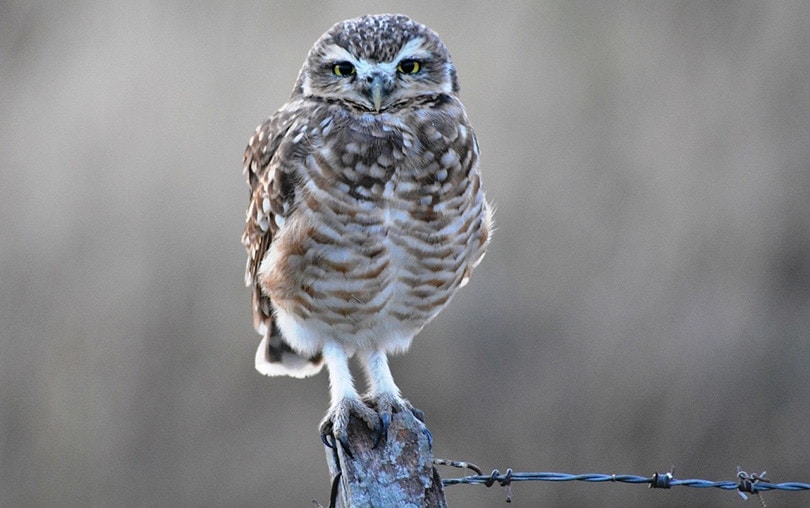Do Owls Have Long Legs? Why Are They So Long?
Last Updated on

When we think of owls, the first things that always come to mind are their impressive colors, wingspan, iconic call, and ability to turn their head almost all the way around. Underneath all their feathers, though, these hunters have another secret. Depending on the species of owl, their legs can be almost half the length of their body!
Birds often have long, skinny legs. The bony structure, rough texture, and talons are their way of gripping onto perches or depending on the species, tearing into their food. The length of an owl’s legs can be deceptive. When they perch, they often hunker down until all you can see of their feet is the impressive talons peeking out beneath their bodies.
Therefore, it can come as a surprise when you see pictures of owls showing off not only their impressive wingspan but also the sheer length of their legs. Check out this guide to learn more about the length of owl’s legs and why the extra length helps them hunt.

Why Do Owls Have Long Legs?
Owls are nocturnal hunters that rely on their silent flight and powerful vision to capture their prey, whether it’s a field mouse or a large moth. They don’t stalk their prey like other hunters do, and while they can walk and run, they don’t do either often, especially not when they’re hunting — although the burrowing owl is an exception here.
When owls swoop down on their prey, they don’t snap it up in their beaks like some other birds do. Instead, they’ll latch on with their talons and lift their catch. The length of their legs gives them the strength that they need to carry away the animals that they prey on. Some owls — the Great Horned Owl, for example — have even been known to whisk away cats, so they need to be able to manage the extra load.
Owls also use their feet to stab or crush their prey and tear it into more manageable, bite-size pieces. With the length of their legs keeping their struggling dinner away from their face and eyes, owls can protect their most important sense from harm. After all, if their eyes are damaged, they’ve lost one of their biggest hunting assets.

What Owl Has the Longest Legs?
There are over 200 species of owl, and with their range of sizes, strengths, and hunting styles, it can be difficult to say which owl has the longest legs. Even the burrowing owl, with their focus on ground hunting, has impressive legs.
As the tallest species of owl, the Eagle Owl is often believed to have the longest legs.
Why Do Owls Stand Still?
Now you know how useful the length of an owl’s legs is, you’re probably wondering why they spend so much time sitting still. With the power that they hold in their legs, they could easily switch between hunting on the ground or in flight.
Owls are birds of prey. As aerial predators, they are built to capture their prey from midflight. While they can stretch out their legs and their talons, latching on without letting go, their silent flight is what makes them such great hunters.
Their ability to sit still for hours enables them to use the coloring of their feathers to their highest advantage. They blend in with the foliage around them and be virtually invisible to their prey. This enables them to watch their prospective dinner scurry here and there until they find an easy, unaware target.

Do Owls Have Feathered Feet?
The density of the feathers covering an owl’s feet depends on their native climate. Areas that snow often requires these hunters to use everything that they can to keep themselves warm. But owls in warm places don’t need as much help and would prefer to stay cool, even at night.
Snowy Owls, Northern Hawk Owls, and Great Gray Owls all live in cold regions. All of them have densely feathered feet and legs. This enables them to perch on snow-covered branches for extended periods without getting cold.
Barn Owls and burrowing owls and many others come from warm climates. While they do have some feathering on their legs, it’s not nearly as dense as owls who reside in colder places. The light layer of insulation keeps these owls cool during warm nights.
Related Read: 53 Fascinating & Fun Owl Facts You Never Knew

Summary
Owls are aerial hunters, and we recognize them by their distinct facial structures, wings, birdcall, and coloring. Whether you’re a fan of owls because of their prominent part in fantasy series or you’re fascinated by their hunting skills, the length of an owl’s legs can be surprising.
Appearances can be deceiving, and although owls often hide their legs from sight, they’re as much of an aid to their hunting as their wings are. Despite their thin appearance, owl legs are powerful enough to crush, tear, and stab their prey, while giving them the strength to whisk their dinner home to eat in comfort.
The impressive length of an owl’s legs also enables the owls to keep their faces out of reach when their prey struggles, protecting their eyes — one of their biggest assets — from damage.
You might also be interested in: How Intelligent Are Owls? Here’s What Science Says
Featured Image Credit: lobozunino, Pixabay
About the Author Robert Sparks
Robert’s obsession with all things optical started early in life, when his optician father would bring home prototypes for Robert to play with. Nowadays, Robert is dedicated to helping others find the right optics for their needs. His hobbies include astronomy, astrophysics, and model building. Originally from Newark, NJ, he resides in Santa Fe, New Mexico, where the nighttime skies are filled with glittering stars.
Related Articles:
How to Clean a Refractor Telescope: Step-by-Step Guide
How to Clean a Telescope Eyepiece: Step-by-Step Guide
How to Clean a Rifle Scope: 8 Expert Tips
Monocular vs Telescope: Differences Explained (With Pictures)
What Is a Monocular Used For? 8 Common Functions
How to Clean a Telescope Mirror: 8 Expert Tips
Brightfield vs Phase Contrast Microscopy: The Differences Explained
SkyCamHD Drone Review: Pros, Cons, FAQ, & Verdict
